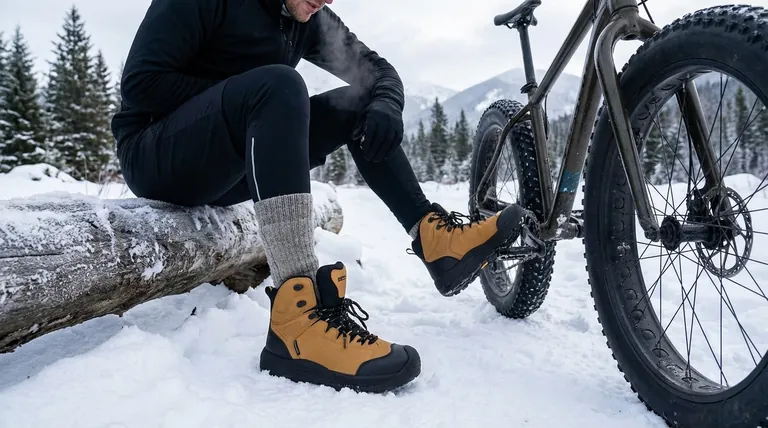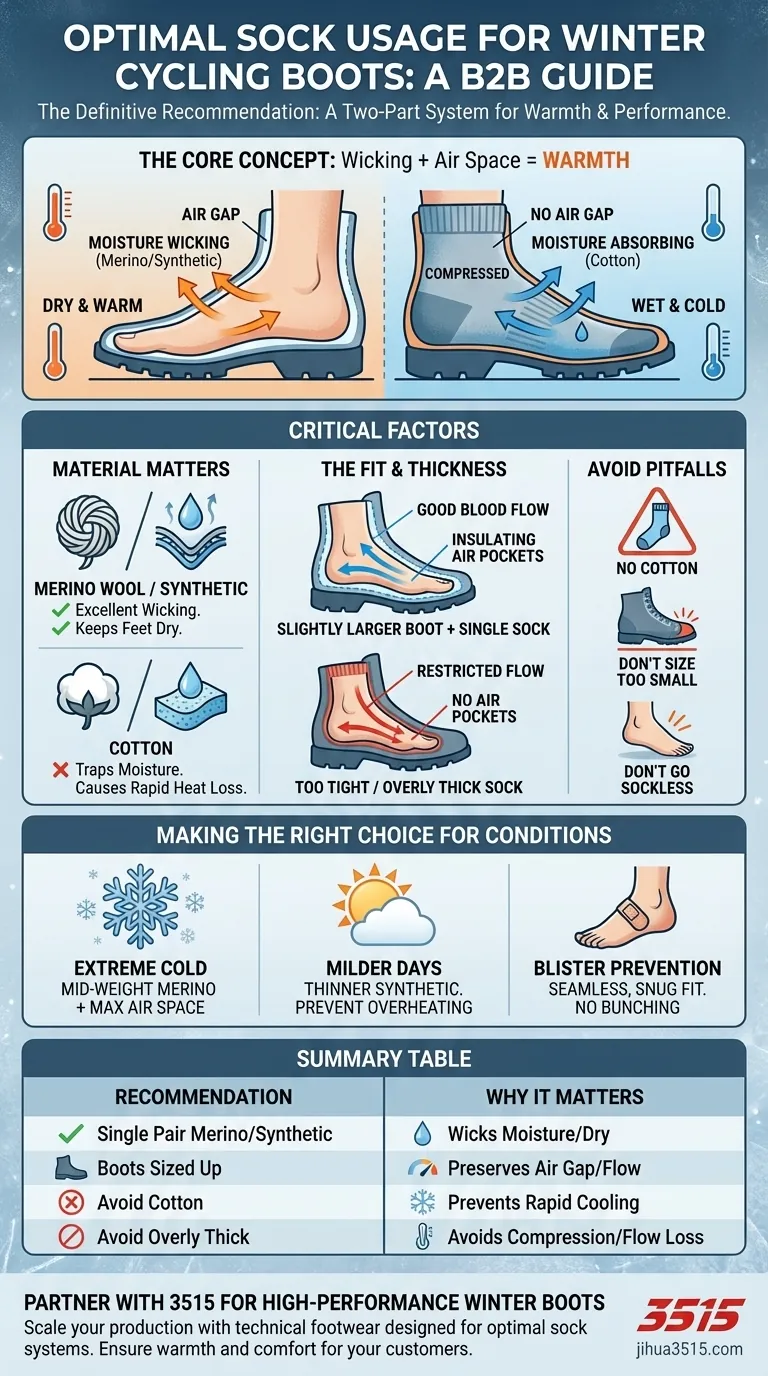For winter cycling, the definitive recommendation is to use a single pair of high-quality merino wool or synthetic socks. You must ensure your boots are sized slightly larger than your street shoes to accommodate the sock while leaving enough air space for proper insulation.
Your primary goal is not to cram in the thickest sock possible. The key to warm feet is a two-part system: a sock that excels at moisture management and a boot that preserves an insulating layer of trapped air.

Why Your Sock Choice is Critical for Warmth
The material and fit of your sock directly impact your body's ability to stay warm. A poor choice can actively work against you, creating the very conditions that lead to cold, uncomfortable feet.
The Role of Moisture Wicking
Your feet will sweat, even in the cold. Merino wool and synthetic fabrics excel at wicking this moisture away from your skin, keeping your feet dry.
Dry feet are warm feet. When moisture evaporates, it cools the surface of your skin, and a wet sock will rapidly steal heat from your foot.
The Myth of "Thicker is Warmer"
The most common mistake is choosing a sock that is too thick for your boot. True insulation comes from trapped air, not just material thickness.
When a thick sock is compressed inside a tight boot, all those insulating air pockets are eliminated. This compression also constricts blood flow, further reducing your body's ability to keep your feet warm.
Preventing Friction and Discomfort
Properly fitted socks are also your first line of defense against blisters and hot spots. They create a smooth, protective barrier between your skin and the stiffer materials of a winter boot.
Common Pitfalls to Avoid
Achieving warm feet is often about avoiding simple mistakes. Understanding these common errors is just as important as choosing the right gear.
The Danger of Cotton Socks
Under no circumstances should you wear cotton socks for winter cycling. Cotton is highly absorbent and loses all of its insulating properties when wet.
Wearing cotton is like wrapping your foot in a wet sponge; it will hold cold moisture directly against your skin, guaranteeing discomfort.
The Boot Sizing Mistake
Your winter cycling boots should be sized up to accommodate your chosen socks without pressure. You should be able to wiggle your toes freely once the boot is on.
If your toes are pressed against the end of the boot or the sides feel tight, your circulation is compromised, and the insulating air gap is gone.
The Fallacy of Going Sockless
Riding without socks eliminates the crucial moisture-wicking layer. It also dramatically reduces insulation and significantly increases the risk of friction, blisters, and foot irritation from the boot's interior seams.
Making the Right Choice for Your Ride
Your specific sock choice depends on the conditions and ensuring your entire foot-sock-boot system works in harmony.
- If your primary focus is maximum warmth in extreme cold: Choose a single, mid-weight merino wool sock and ensure your boots are large enough to preserve air space and blood flow.
- If your primary focus is comfort on milder winter days: A thinner wool or synthetic sock is ideal to prevent your feet from overheating and sweating excessively, which can lead to coldness later.
- If your primary focus is preventing blisters: Prioritize a sock with a seamless construction and a snug, anatomical fit that will not bunch or slide inside your boot.
Ultimately, managing moisture and preserving space is the key to warm feet on any winter ride.
Summary Table:
| Recommendation | Why It Matters |
|---|---|
| Single Pair of Merino Wool/Synthetic Socks | Excellent moisture wicking keeps feet dry and warm. |
| Boots Sized Slightly Larger | Preserves an insulating air gap and prevents circulation loss. |
| Avoid Cotton Socks | Cotton holds moisture, causing rapid heat loss and cold feet. |
| Avoid Overly Thick Socks | Compression eliminates air pockets and restricts blood flow. |
Keep Your Customers Riding Comfortably with High-Performance Winter Boots
As a large-scale manufacturer, 3515 produces a comprehensive range of footwear for distributors, brand owners, and bulk clients. Our production capabilities encompass all types of shoes and boots, including technical winter cycling models designed with the precise fit and insulation needed for optimal performance.
Partner with us to supply your customers with boots that perfectly complement the right sock choice, ensuring warmth, dryness, and comfort on every ride. Let's discuss your specific needs and how we can support your business.
Contact our team today to explore our manufacturing solutions.
Visual Guide

Related Products
- Premium Insulated Safety Boots and Shoes for Wholesale & Bulk Orders
- Wholesale Breathable Training Shoes Custom Athletic Footwear Manufacturer
- Wholesale Training Shoes with Dial Lacing System Custom OEM Manufacturing
- Wholesale Durable & Breathable Training Shoes for Custom Brands
- Durable Rubber-Soled Utility Shoes for Wholesale & Custom Brand Manufacturing
People Also Ask
- Why is keeping feet warm important during winter work? Protect Your Health and Safety on the Job
- What features should one look for when selecting supportive winter footwear? Secure Your Stride with the Right Support
- Can insulated work boots be worn in warmer weather? Avoid Discomfort and Foot Health Risks
- Why is it important to keep feet dry during winter? Prevent Frostbite & Infections
- What is Thinsulate and how does it function in insulated boots? Achieve Superior Warmth Without Bulk



















